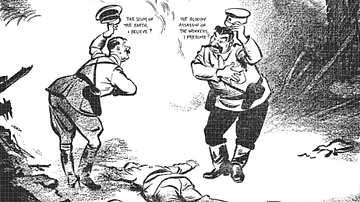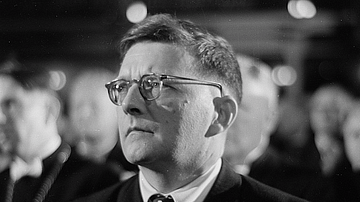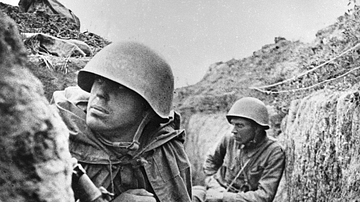Search
Remove Ads
Advertisement
Summary 
Loading AI-generated summary based on World History Encyclopedia articles ...
Search Results

Definition
German-Soviet War - WWII's Bloodiest Front
The German-Soviet War, known in the USSR and today's Russia as the Great Patriotic War or, in Western Europe, as the Eastern Front of the Second World War (1939-45), began in June 1941 with Operation Barbarossa and ended in Germany's total...

Definition
Nazi-Soviet Pact
The Nazi-Soviet Pact, also called the Molotov-Ribbentrop Pact after the respective foreign ministers of the USSR and Germany, was a non-aggression agreement signed in August 1939. The pact allowed the leader of Nazi Germany Adolf Hitler (1889-1945...

Video
Why Hitler Invaded the Soviet Union
Sign up to World of Warships with our link for a free starter pack worth €25: https://wo.ws/3YW2PoX In the summer of 1941 Adolf Hitler launched Operation Barbarossa, his invasion of the Soviet Union. Often described as an epic strategic...

Article
Battle of Kursk - Largest Tank Battle in History
The Battle of Kursk (Jul-Aug 1943), which involved nearly 6,000 tanks, was the largest tank battle in history and ended in a decisive victory for the Red Army in WWII (1939-45). Two Axis armies had attempted to cut off a Red Army bulge in...

Definition
Operation Barbarossa - Hitler's Invasion of the USSR
Adolf Hitler (1889-1945), leader of Nazi Germany, attacked the USSR on 22 June 1941 with the largest army ever assembled. The Axis offensive of June-December 1941 was code-named Operation Barbarossa ('Redbeard') after Frederick Barbarossa...

Definition
Dmitri Shostakovich
Dmitri Shostakovich (1906-1975) was a Russian composer of operas, ballets, concertos, string quartets, and 15 symphonies. Shostakovich was frequently denounced by the repressive Soviet state, but in some periods, he also gained official favour...

Article
Battle of Smolensk in 1943 - Operation Suvorov
The Battle of Smolensk in August to September 1943 was the second time the Soviet Union and the Third Reich fought over the city on the Dnieper during the Second World War (1939-45). By the summer of 1943, the plan by Adolf Hitler (1889-1945...

Article
The Red Army in WWII
The Red Army of the USSR began the Second World War (1939-45) with a series of shocking defeats, but from late 1942, it rallied and held on to key cities like the capital Moscow, Leningrad (Saint Petersburg), and Stalingrad (Volgograd). Then...

Article
Siege of Leningrad
The siege of Leningrad (Saint Petersburg) began during Operation Barbarossa, the invasion of the USSR launched by the leader of Nazi Germany, Adolf Hitler (1889-1945), during the Second World War (1939-45). The siege or blockade lasted from...

Article
Siege of Sevastopol in 1941-2
The siege of Sevastopol (Oct 41 to Jul 42) was an attack by Axis forces on the base of the USSR's Black Sea Fleet during Operation Barbarossa of the Second World War (1939-45). Sevastopol (aka Sebastopol) had one of the world's strongest...